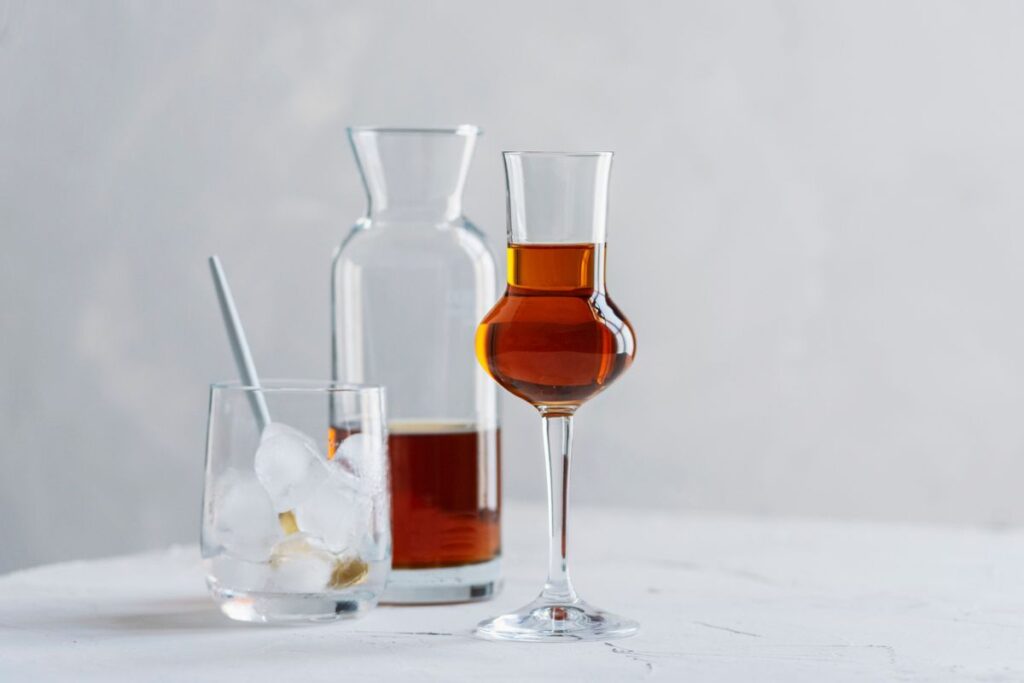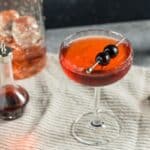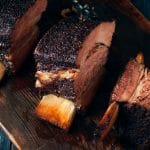Quick summary: Typical substitutes for Amaro Nonino are other brands of Amaro, then Vermouth, Chartreuse, and Bonal Gentaine Quina. These replacements can come in handy depending on what flavor you are up for or what cocktail you are preparing.
Happy hour doesn’t have to turn gloomy just because you don’t have Amaro Nonino for your favorite Paper Plane cocktail. We’ll help you maintain all that happiness with an Amaro Nonino substitute that’s just as delicious.
Since Amaro Nonino is an imported liqueur, it’s not always easy to find and once you do, it can be pricey. Whether you’re looking for a post-dinner drink to have neat or shaking up your favorite celebratory cocktails, here’s a full guide on the best substitutes for Amaro Nonino.
What Is Amaro Nonino?
Amaro means ‘little bitter’.
Amaro Nonino is an Italian amaro, but what sets it apart from other liqueurs is its unique herbal complexity, the way it is made, and its price. Despite similar products produced in Europe, the term ‘amaro’ is applied to Italian liqueurs only.
Other types of amaro (or Amari) you might be familiar with are Aperol, Campari, and Averna. Amaro Nonino, however, has a much higher ABV (around 35%) than other varieties.
This Italian herbal liqueur has a golden amber color and is made by infusing grappa or neutral spirits with a wide selection of herbs, botanicals, and fruits.
The mixture is aged, creating a complex bittersweet flavor with prominent notes of citrus, mango, pepper, allspice, and licorice. Other background flavors that come through are dark caramel, vanilla, cocoa, and honey.
The liqueur is generally enjoyed neat as an after-dinner digestif. Some people prefer it on ice, or with tonic water and a citrus wedge.
It is also a popular addition to the Paper Plane cocktail which includes Amaro Nonino, Aperol, bourbon, and lemon juice.
How to Choose the Best Substitute
When looking for an Amaro Nonino substitute, we recommend finding something within the same bitter Italian liqueur category.
Focus on the flavors you want to accent and choose a substitute based on that. For example, if you are looking to highlight the citrus flavor, look for something that equally accents citrus. If the spicy flavor, pepperiness or bitterness is more important, look for a peppery bitter liqueur.
If amaro is not something you generally keep around the house, we’ll also give you some other commonly accessible options for an easy fix.
Best Amaro Nonino Substitutes
In the same way that choosing a red wine to replace another red or one whiskey to replace another, using alternative amaro liqueurs will give you the closest match. They are produced in somewhat similar ways and have flavor profiles that have correlating herbal, fruity, and bitter notes.
Since there are so many varieties to choose from, our top recommendations to substitute Amaro Nonino are Amaro Averna, Meletti, or Tosolini.
1. Amaro Averna
This is one of the closest flavor matches you will get with strong citrus notes and caramel undertones. Where it differs a little is that it is sweeter with a more syrupy consistency and a lower ABV (alcohol by volume) of around 29%.
Although it doesn’t have extremely prominent herbal or spicey flavors it can be used in equal quantities in cocktails or drunk neat as a digestif.
2. Amaro Meletti
Meletti is also bittersweet and herbaceous in flavor with caramel and cocoa undertones as well as hints of anise and saffron. With a similar ABV at 32%, it makes an ideal replacement as a straight drink or in cocktails. Although it is also an Italian product, it has a significantly lower price tag.
3. Amaro Tosolini
This unique and complex liqueur contains 15 ingredients with prominent orange and herbal flavors. It also offers a similar bitterness but has a darker amber and burgundy color which could affect the color of your cocktails.
With an ABV of 30%, it makes a close match as an aperitif, digestif, or in mixed drinks. We recommend mixing two ounces of rye whiskey, one ounce of Tosolini, and a touch of bitters with a citrus or cherry garnish. Enjoy!
4. Vermouth
Vermouth is at the top of our list not because it is the closest match in flavor or color, but because it is both easy to find and budget friendly compared to most other options.
Vermouth is a fortified wine or wine-based liqueur. That means it has been fortified or infused with herbs, spices, and botanicals, just like most amaros.
Vermouth has a similar citrus flavor profile with spice notes of star anise and allspice. It has a much lower ABV around 16% to 18%.
There are, however, different types of vermouth, so we advise checking the ingredients label to determine whether the flavor profile closely matches what you are looking for.
Vermouth is divided into red or sweet vermouth and dry or white vermouth. Although it does not have an excessively sweet flavor, the red type has a lot more sugar than the white with a spicy and earthy flavor profile and a hint of bitterness.
It is used in classic cocktails such as the Manhattan and Negroni.
Dry vermouth has only a very small percentage of sugar giving it a crisp dry taste. It is used to make a Classic Martini and Dirty Martini. Both types can also be enjoyed straight.
Spices, herbs, and botanicals used in vermouth that are reminiscent of Nonino are citrus, juniper, oregano, ginger, sage, star anise, cinnamon, cardamom, allspice, cloves, and vanilla.
Here’s your guidance on Vermouth shelf life if you feel like the bottle’s been standing in the cabinet for too long.
5. Chartreuse
Chartreuse is a well known French liqueur. Although it comes in different flavor profiles, all types have a robust earthy, spicy, and botanical complexity with a low bitterness.
The two main types are green and yellow Chartreuse.
Green Chartreuse has an ABV of 55% compared to the yellow type which has a 40% ABV—which is still higher than that of Amaro Nonino.
Yellow Chartreuse is milder and sweeter compared to the green variety. Regardless of the variety you choose, start with slightly less in cocktails due to the strong flavor and high alcohol content. Then, if needed, add a little more to taste.
6. Bonal Gentaine Quina
Bonal Gentaine Quina Liqueur has a fortified wine base similar to vermouth and is infused with botanical, herbs, and spices which gives it the citrus and licorice flavors that you are after.
Some big differences to keep in mind are that it has a much darker color and intense cherry flavors.
Despite this many people still enjoy using it as a substitute. It contains quinine which gives it a bitter taste similar to most types of Amari.
7. Angostura Bitters
Bitters are popular for a variety of mixed drinks and cocktails. The concentrated alcoholic liquid (44.7% ABV) is made largely from orange peels and herbs including cloves and cinnamon.
Note that bitters is not a liqueur and is more generally classified as a food ingredient (although you will find it at a liquor store).
You only need to add a few drops to your drink for flavor, so use it very conservatively as a replacement.
8. Gammel Dansk
Gammel Dansk makes a fantastic substitute since it is spiced and bitter while still having some fruity flavor and sweet notes.
This Danish bitter is made from around 29 different herbs and spices and displays prominent flavors of cinnamon, star anise, Seville orange, and ginger.
It also has a similar golden-brown color which means your drink will look and taste very much the same regardless of the substitution.
9. Chinotto
If the reason you’re looking for a substitute is that you are making mocktails, Chinotto should be your go-to.
This carbonated soft drink is made from the fruit of a myrtle-leaved orange tree and has a dark color similar to cola. It has a bittersweet flavor just like Nonino, but without the alcohol which also makes it child friendly.
10. Cynar
Cynar is actually an amaro but it is very different from most other types. Traditional or regular Cynar is made using 13 botanicals and herbs and displays a strong orange taste with bitter chocolate notes. It has a dark amber/dark brown color and is 16.5% ABV.
Cynar 70 is a much stronger type in both flavor and alcohol content. It has darker flavors of chocolate and coffee with a hint of orange.
You can use both as a substitute, but will likely need less Cynar 70 than regular Cynar and the prominence of the citrus flavors will differ.
11. Amaro Ramazzotti
Amaro Ramazzotti is one of the oldest Italian liqueurs. It has a similar bittersweet taste with prominent citrus notes and a complex flavor profile of berry, licorice, star anise, spices, espresso, and dark chocolate.
The drink has a thick consistency and 30% ABV. It is traditionally served over ice with a ginger garnish. It also pairs very well with rum and pineapple juice.
FAQ
While both are part of the Amari family and have bitter orange flavor notes, Campari has a much brighter color, lower ABV, and is more bitter. Both drinks are enjoyed as a digestif, so you can use it as a replacement for after-dinner drinks.
Aperol is sometimes used together with Nonino in cocktails and is also served as a digestif. Both have a bitter flavor and strong orange taste. Although it can be used as a replacement, keep in mind that Aperol has a much lower alcohol content.
There are many different opinions on refrigerating amaro and part of this could be the varying alcohol content between types and brands.
As a general rule for any alcohol, if it is wine-based and has an ABV of 15% or less, it will last best when refrigerated. Many aperitifs and digestifs have delicate herbal flavors which benefit from being refrigerated.
While leaving a bottle of open wine or Amari unrefrigerated for a week won’t necessarily make you ill, you won’t get the best quality out of it when it’s time for happy hour.
Whether you want a refreshing beverage for summer sundowners or the spicy notes and rich flavor of a tasty digestif, there are a great deal of Amaro Nonino alternatives you can choose from if you don’t have any on hand.
For a close matching Amaro Nonino taste we always recommend using another Amari liqueur. However, an easy-to-find option like vermouth can also give you a similar herbal flavor profile.
On the other hand, adding Angostura Bitters to any drink can provide a strong taste with a bitter orange profile.
Regardless of the option you choose, be mindful of the herbal strength and alcohol content and adjust your ratios accordingly. Happy ‘happy hour’!
*image by Nolonely/depositphotos









